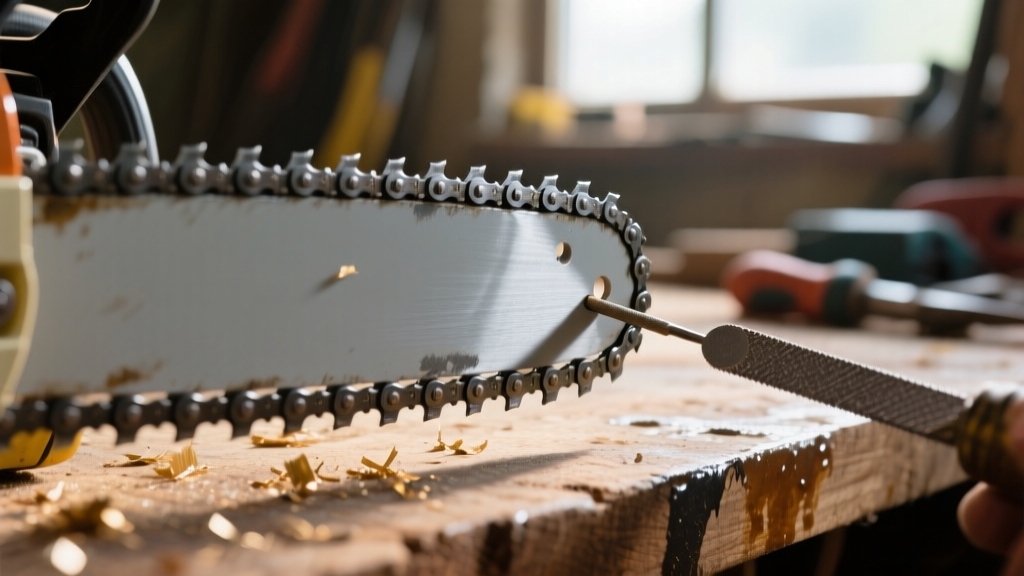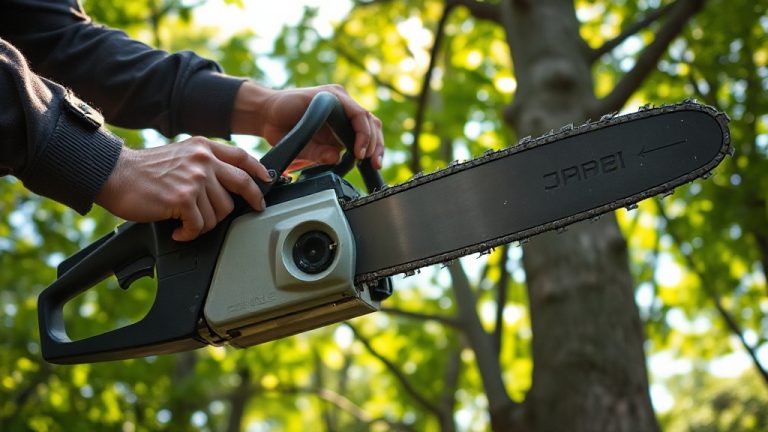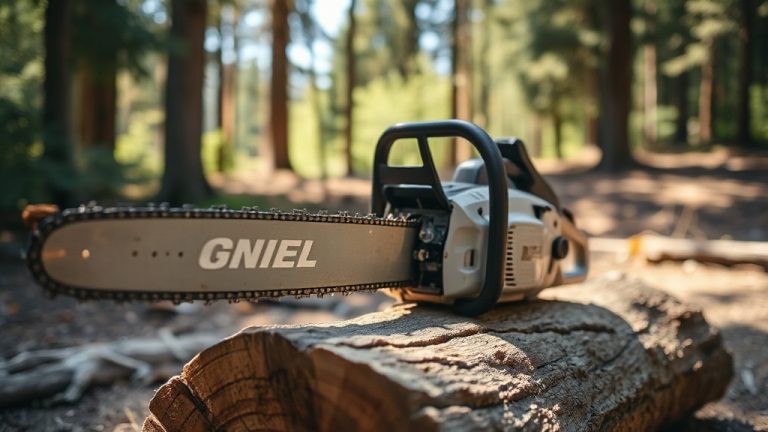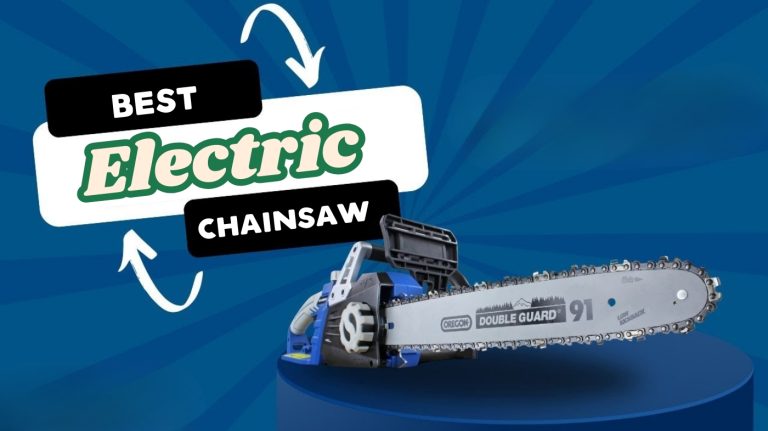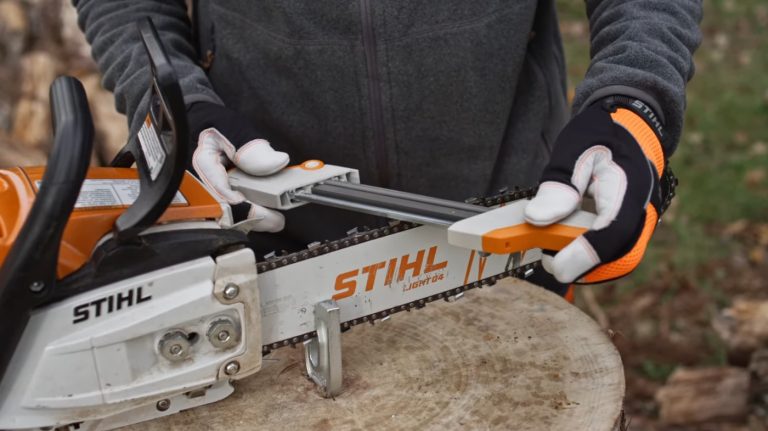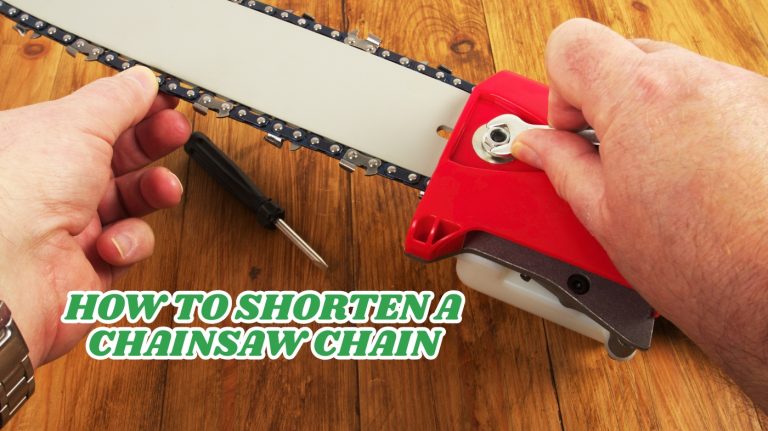Best Angle to Sharpen Chainsaw Chain: Maximum Cutting Power
You should sharpen your chainsaw chain at an angle between 25° and 40°, tailored to the type of wood you’re cutting. Softer wood benefits from a steeper 35°–40° angle for faster cutting, while hardwood or frozen wood calls for a blunter 25°–30° angle to maintain edge durability.
Keep the outside side plate just under 90° for smooth feed. Always use guides or gauges to maintain precision. Understanding these nuances helps maximize your chain’s longevity and cutting efficiency.
Key Takeaways
- Sharpen inside top plate angles between 25° and 40°, adjusting 35°-40° for soft wood and 25°-30° for hardwood or frozen wood.
- Maintain outside side plate angles close to 85°-90° for smooth chain feed and optimal cutting performance.
- Use a filing guide or chain sharpening gauge to consistently set and preserve the correct sharpening angles.
- Consistent angles across all teeth reduce kickback risk, improve efficiency, and extend chain service life.
- Regularly check and maintain depth gauges alongside sharpening angles to ensure safe and effective cutting.
Typical Sharpening Angles for Different Chainsaw Chains
When sharpening your chainsaw chain, understanding the typical angles for the inside top plate and outside side plate is essential to maintain cutting efficiency and chain durability.
Most inside top plate angles range between 25° and 40°, with softer wood favoring around 35° to 40° for faster cutting. Blunter angles are preferred for hard or frozen wood because they help support the edge.
Inside top plate angles typically range from 25° to 40°, with softer wood favoring 35° to 40° for speed. Hardwood and frozen wood require sharper angles near 25° to 30° to prolong edge life.
The outside side plate angle usually lies between 85° and 90°, ensuring smooth chain feed and stable cutting. The angle should be just under 90 degrees, never less than 85, to avoid excessive back slope that could impair cutting.
Chisel chains generally use a 25° top plate angle for precision and durability, whereas semi-chisel chains favor about 30° for versatility and better wear resistance. Consistency in these angles during sharpening preserves chain performance and extends service life.
Impact of Sharpening Angle on Cutting Performance
Hey there! So, let’s talk about the sharpening angle and how it impacts cutting performance. You see, the angle plays a big role in how well the chain cuts through wood. When the angle is just right, it helps the chain bite into the wood more aggressively, making your cuts smoother and quicker.
Now, here’s something to keep in mind: it’s really important to maintain consistent angles across all the teeth of the chain. Incorrect angles can lead to reduced cutting efficiency and even cause kickback, which can be dangerous.
Why? Because that consistency ensures balanced cutting and helps prevent uneven wear. If you don’t pay attention to the precision of those angles, you might find that your cutting performance takes a hit. Plus, you could end up putting in a lot more effort than necessary while using the tool.
Angle Effects on Efficiency
Since the sharpening angle directly influences how the chainsaw chain interacts with wood, understanding its effects on cutting efficiency is crucial.
A sharper inside top plate angle (around 30°) slices wood faster but dulls quickly. A blunter angle (near 40°) slows cutting but enhances durability. It is important to use a round saw chain file suited to the chain pitch for sharpening to maintain optimal cutting performance.
The outside side plate angle, ideally 85°–90°, guarantees smooth chain feeding and reduces grabby behavior. Balancing these angles according to wood type optimizes performance and maintenance frequency.
| Angle Type | Effect on Efficiency |
|---|---|
| Inside Top Plate 30° | Faster cutting, quicker dulling |
| Inside Top Plate 40° | Slower cutting, longer edge life |
| Side Plate 85°–90° | Smooth feed, better control |
| Side Plate <85° | Grabby feel, harder sharpening |
| Sharper Angles (25°–30°) | High efficiency, frequent sharpening |
Angle Consistency Importance
Although it might seem minor, maintaining a consistent sharpening angle is essential for balanced cutting performance and safety. When you keep the angle uniform, each tooth maintains its designed profile, ensuring the chain cuts straight and smoothly.
Inconsistent angles cause uneven tooth wear, resulting in the chain pulling to one side and increasing operator fatigue and risk of kickback. Angle deviations also reduce cutting efficiency, forcing more engine power and accelerating dulling. Errors in filing chains can accumulate, worsening the sideways problem.
By sharpening at the manufacturer-recommended angle consistently, you preserve tooth edge strength and optimize chip removal, extending chain lifespan. Using guides or jigs to verify angles helps you avoid microfractures and maintain control.
How to Measure and Maintain the Correct Sharpening Angle?
To measure the right sharpening angle, you can use a chain sharpening gauge or a file guide. Just set it to the degree recommended by the manufacturer, which is usually between 25° and 35°. It is important to follow the manufacturer’s directions to ensure safety and optimal performance.
Now, to keep everything consistent, it’s a good idea to secure the chainsaw bar first. Once that’s done, you can start filing each tooth. Just make sure to use steady, uniform strokes while keeping that angle you set.
By using these tools and techniques, you’ll ensure that your angles are precise. This not only optimizes cutting efficiency but also helps prolong the life of your chain.
Angle Measurement Tools
Accurate angle measurement tools play an essential role in maintaining the correct sharpening angle for your chainsaw chain. You can use file angle plates with preset markings like 25° or 30° to guide your file precisely during sharpening.
Pitch-N-Gauge tools offer multi-functional measurements, verifying chain pitch, file size, and preset angles for accuracy. Manual sharpening guides stabilize your file or rotary tool, guaranteeing consistent angles. Rotary sharpening guides mechanically maintain precise tilt.
Digital or mechanical protractors help you measure the tooth angle relative to the bar for setup and verification. Additionally, marking a blade tooth with a felt tip pen helps monitor and ensure even material removal during sharpening for uniform cutting performance.
Consistent Angle Techniques
Measuring and maintaining the correct sharpening angle requires more than just the right tools; it demands consistent technique and attention to detail.
Start by referencing the manufacturer’s scribed angle on each cutter, typically between 25° and 35°. Hold the file steady with even pressure, maintaining a consistent stroke length to replicate this angle across all cutters.
Visually align the file handle with the chain’s motion path to keep the top plate near 45° and the side plate nearly vertical with a slight curve. It is important to focus on all cutting surfaces, including the side plate, top plate, and point, to achieve an even and effective sharpening.
Regularly compare tooth lengths and tooth alignment to guarantee uniformity. Test cuts confirm whether angles remain accurate. Remember, even minor angle deviations reduce cutting efficiency and accelerate wear. Meticulous, repeatable technique is essential for peak chainsaw performance and chain longevity.
Sharpening Techniques for Optimal Angle Consistency
When you sharpen a chainsaw chain, maintaining a consistent angle is essential for preserving cutter geometry and guaranteeing efficient cutting performance.
To achieve this, use filing guides or bar-mounted sharpeners that set precise angles, typically between 25° and 35° for side plates and about 45° for top plates. Using a file guide helps ensure the correct angle is maintained throughout the sharpening process.
Align your file or grinding wheel carefully, applying moderate, even pressure to avoid angle deviations or oversharpening. Check angles regularly with gauges or cutter reference marks to guarantee uniformity across all cutters.
Sharpen multiple cutting surfaces simultaneously to maintain geometry and improve cutting efficiency. It is also important to monitor the raker height consistently during the sharpening process to ensure optimal chain performance.
Avoid changing factory-set angles without proper knowledge, as it affects chain tracking and durability. Consistent angles reduce metal removal, extend edge life, and enhance saw performance by minimizing power draw and cutting irregularities.
Angle Variations Based on Wood Type and Cutting Conditions
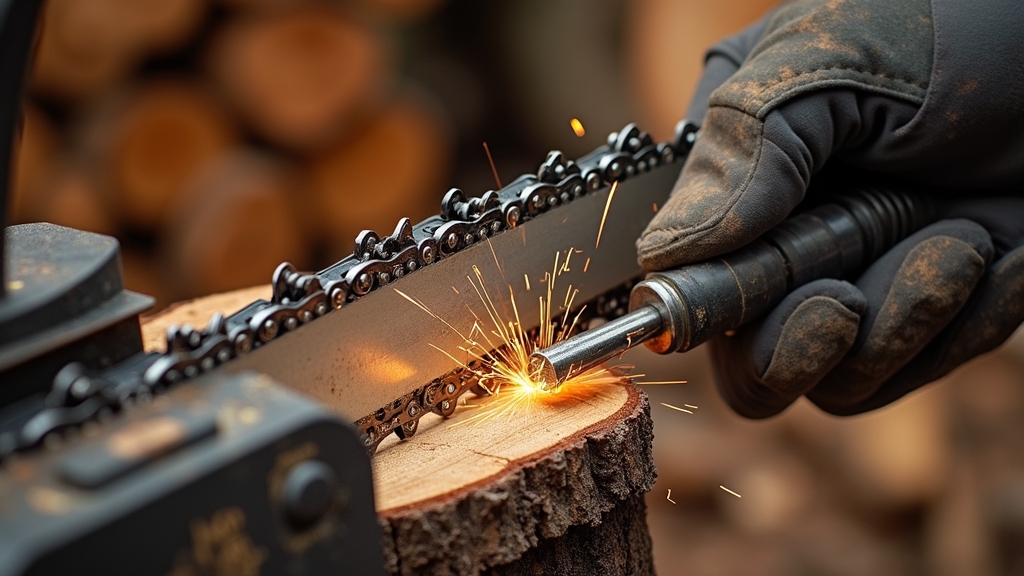
Although factory-set sharpening angles provide a reliable baseline, adjusting the chain’s angle based on wood type and cutting conditions can greatly enhance performance and durability.
Factory-set angles are a good start, but tailoring sharpening to wood type improves cutting efficiency and tool life.
For softer, clean wood, sharpening the inside top plate around 40° maximizes cutting efficiency. It is important to maintain a 30° top plate angle as a general guideline to ensure effective cutting without binding.
When cutting hard, frozen, or abrasive wood, blunter angles strengthen the edge and extend sharpening intervals, despite reducing cutting speed. Outside side plate angles should stay just under 90°, ideally above 85%, to maintain a beneficial back slope for smooth chain feed.
Sharpen top plate angles between 15° and 35%, choosing higher angles for speed and lower angles for edge retention, especially in abrasive conditions. Additionally, select chisel or semi-chisel chain angles based on wood cleanliness and hardness to optimize cutting action and durability.
Tools and Devices for Accurate Angle Sharpening
To achieve consistent and precise sharpening angles, you’ll rely on specialized tools and devices designed to stabilize both the chain and the file or grinding bit.
Filing guides clamp the round file at preset angles, commonly 25°, 30°, or 35°, ensuring consistent cutter profiles. Filing vices immobilize the chain, enhancing safety and accuracy during manual sharpening.
Electric sharpeners feature adjustable angle settings and diamond grinding bits tailored to chain types, delivering repeatable precision and speed. Proper clamping of the chainsaw in a vice is crucial for effective sharpening to prevent movement and ensure accuracy during the process.
Angle-setting tools like protractors and multi-functional gauges verify correct filing angles and chain pitch, preventing over- or under-sharpening. Files and grinding bits must match chain pitch and be replaced when worn to maintain angle accuracy.
Integrated sharpening systems combine these components, streamlining the process and ensuring durable, efficient cutting edges. The Stihl 2in1 Easyfile is an example that sharpens both the cutter and the raker gauge simultaneously, simplifying maintenance 2in1 Easyfile.
Differences in Sharpening Angles Between Chain Types
Sharpening angles vary considerably between full chisel and semi-chisel chains, reflecting their distinct cutting designs and performance requirements.
Full chisel chains use sharper angles, typically 25° to 30°, optimizing speed and cutting efficiency on clean wood. These chains have square cutting edges that maximize cutting speed but require careful sharpening.
Semi-chisel chains generally employ a 30° angle to balance sharpness with edge durability, making maintenance easier. Specialized full chisel chains may require angles up to 35° for maximum speed, but excessive deviation can shorten chain life.
Semi-chisel chains tolerate rounded edges and are less sensitive to angle variations. Additionally, the design of tie straps helps maintain chain integrity during use.
| Chain Type | Typical Angle Range | Edge Characteristic |
|---|---|---|
| Full Chisel | 25°–30° (up to 35°) | Sharp, aggressive |
| Semi-Chisel | ~30° | Durable, balanced |
| Round Cutter | Moderate | Easy maintenance |
| Square Tooth | 25°–30° | Faster cutting |
| Manufacturer Spec | 25°–35° | Chain-specific guidance |
Common Mistakes to Avoid When Setting Sharpening Angles
When you set sharpening angles incorrectly, the chain’s cutting efficiency suffers and wear accelerates unevenly. Avoid filing cutters at inconsistent or incorrect angles, such as deviating from the manufacturer’s specified 35° to 30°, to preserve edge profile and cutting power.
Don’t neglect depth gauge maintenance. Failing to lower it after sharpening reduces chip size and causes inefficient cutting, while over-filing increases kickback risk. Proper filing of depth gauges is essential to prevent saw bogging and ensure safety.
Use the correct file size and replace dull files promptly to maintain accuracy and prevent cutter damage. Stabilize the saw bar firmly during sharpening to guarantee angle consistency and safety.
Finally, adopt proper filing technique: file from outside in, maintain consistent strokes, and avoid excessive pressure to sustain the intended sharpening angle and extend chain longevity. A sharp file is necessary for effective sharpening.
Frequently Asked Questions
How Often Should I Sharpen My Chainsaw Chain for Best Results?
You should sharpen your chainsaw chain every time you refill fuel and oil or after about 3 hours of cutting, depending on use. If you notice fine sawdust, smoke, uneven cuts, or the saw struggling, sharpen immediately.
Frequent touch-ups maintain sharpness, reduce effort, and extend chain life. Adjust sharpening frequency based on wood type, cutting conditions, and debris exposure to keep your chain performing efficiently and safely.
Can Sharpening Angles Affect Chainsaw Fuel Efficiency?
Yes, sharpening angles directly affect your chainsaw’s fuel efficiency. When you maintain the correct angles, your chain cuts smoothly with less resistance, reducing engine load and fuel consumption.
Incorrect angles increase cutting difficulty, forcing your motor to work harder and consume more fuel. Consistently sharpening at recommended angles preserves cutter integrity, lowers fuel use, and extends chain life.
Does Climate Impact How Frequently I Should Adjust Sharpening Angles?
Yes, climate does impact how often you should adjust sharpening angles. In colder or abrasive environments, chains dull faster, prompting more frequent maintenance.
However, angle changes themselves are less common and usually tied to cutting tasks rather than climate alone. You’ll likely maintain standard angles but increase sharpening frequency. Regular inspection and upkeep are essential in harsh climates to guarantee peak cutting efficiency and chain longevity.
Are Sharpening Angles Different for Professional Versus Homeowner Chainsaws?
Yes, sharpening angles differ between professional and homeowner chainsaws. You’ll use precise, manufacturer-specified angles, often 25° for chisel and 30° for semi-chisel chains, in professional settings to maximize cutting efficiency and durability.
For homeowners, angles between 25° and 30° are common, with less strict adherence since casual use tolerates slight deviations without major performance loss. Professionals rely on exact angles, while homeowners prioritize ease over precision.
How Does Sharpening Angle Influence Chainsaw Chain Lifespan?
Your sharpening angle directly affects your chainsaw chain’s lifespan. Sharper angles (30°–35°) cut faster but dull quicker, reducing chain longevity, especially in dirty or abrasive conditions.
Blunter angles (around 25°) slow cutting speed but maintain sharpness longer, extending chain life by minimizing wear. Choosing the right angle for your environment and wood type helps balance cutting efficiency and durability, ensuring you get the most out of your chain before needing replacement.
Find the Perfect Chainsaw Chain Sharpening Angle for Every Wood Type
You now know that maintaining the correct sharpening angle, typically between 25° and 35°, can improve your chainsaw’s cutting efficiency by up to 30%. By measuring and consistently sharpening at the ideal angle for your chain type and wood conditions, you’ll extend chain life and boost performance.
Avoid common mistakes like uneven angles and use proper tools to guarantee precision. With this knowledge, your chainsaw will stay sharper, safer, and more effective during every cut.

